
Review Article
J Dent & Oral Disord. 2024; 10(1): 1183.
Global Map of Skeletal and Dental Malocclusion Prevalence: From Classes to Continents
Iqbal M Lone¹; Kareem Midlej¹; Osayd Zohud¹; Eva Paddenberg²; Sebastian Krohn²; Christian Kirschneck³; Peter Proff²; Nezar Watted4-6; Fuad A Iraqi1,2,6*
1Department of Clinical Microbiology and Immunology, Sackler Faculty of Medicine, Tel Aviv University, Tel Aviv 6997801, Israel
2University Hospital of Regensburg, Department of Orthodontics, University of Regensburg, Germany
3Department of Orthodontics, University of Bonn, D-53111 Bonn, Germany
4Center for Dentistry Research and Aesthetics, 45911 Jatt, Israel
5Department of Orthodontics, Faculty of Dentistry, Arab America University, 919000 Jenin, PNA.
6Gathering for Prosperity initiative, Israel.
*Corresponding author: Fuad A Iraqi Department of Clinical Microbiology and Immunology, Sackler Faculty of Medicine, Tel Aviv University, Tel Aviv 6997801, Israel. Email: fuadi@tauex.tau.ac.il
Received: January 23, 2024 Accepted: March 08, 2024 Published: March 15, 2024
Abstract
Malocclusion, ranked by the WHO as the third most critical oral health concern, impacts 39% to 93% of adolescents and teenagers worldwide, exhibiting variations influenced by age and ethnicity. Across sagittal, transverse, and vertical orientations, malocclusion poses physiological and social challenges, with 46% experiencing negative lifestyle impacts. To assess global prevalence and characteristics, Authors reviewed articles on skeletal abnormalities and malocclusions from the early 1990s to September 2023. Criteria included English-language research studies or meta-analyses focusing on Class I, Class II, and Class III malocclusions, malocclusion incidence, and dental anomalies such as open bite, deep bite, overjet, crowding, spacing, and crossbite. Prevalence globally varied for Class I (1.7-93.6%), Class II (7.4-84.0%), Class III (0.8-72.1%), and Angle Class I (0.5- 31 39.1%). Deep bite incidence ranged from 8.4% to 51.5%, influenced by ethnic and gender cofounders. Geographic variations were attributed to genetic and environmental factors, alongside methodological disparities, and categorization issues. Ambiguities in malocclusion prevalence arose from diverse research methodologies. Orthodontic epidemiology urgently requires standardized guidelines accepted by academia and professional groups to provide reliable data for healthcare recommendations. Geographic variations, influenced by genetic and environmental factors, contribute to the diverse prevalence of malocclusion globally. Methodological disparities and categorization issues create challenges, necessitating urgent development of standardized guidelines for orthodontic epidemiology. These guidelines, embraced by academia and professional groups, are crucial for providing accurate data to inform healthcare recommendations.
Keywords: Skeletal Occlusion; Malocclusion; Prevalence; Angle class; Continent; Epidemiology
Introduction
Malocclusion ranks third in importance to periodontal disease and caries in the WHO's list of oral health issues [1]. According to the estimates [2], it affects children and teenagers at a rate that ranges from 39% to 93% of the worldwide population. There are many variations within this prevalence range between the different populations [2]. This heterogeneity may be caused by the varying ages and ethnicities of the patients in the studies determining the prevalence of malocclusion [3]. The three spatial planes of sagittal, transverse, and vertical are all capable of hosting malocclusions. By analysing the A point-Nasion-B point (ANB) angle, which stands for the anteroposterior intermaxillary relationship, three distinct types of skeletal relationships in the sagittal plane can be iden tified. When the ANB angle ranges from 0° to 4°, the skeletal I is present (Figures 1A and 55 2). Due to the jaw bases' harmonious growth in this instance, the relationship between the 56 upper and lower jaws is correct. There is a change in the relationship between the maxilla and mandible bases with the upper jaw prognathic in relation to the mandible, a retrognathic position of the mandible retracted mandibular angle, or a combination of both conditions when the ANB angle is more than 4° in cases of skeletal class II (Figures 1B and 60 3). [4]. The ANB angle must be less than 0° to fall under skeletal class III (Figures 1C and 61 4). When the mandible projects beyond the upper jaw, the upper jaw retrudes, or both situations coexist [5], there is a change in the relationship between the two maxilla and mandible bases. In the same plane, borders evaluating the overjet or the amount of horizontal overlap between the incisal border is possible. The values range from 2 +/- 2 mm away from the occlusal level, and in the event of a retrognathic overjet, the subject will exhibit a reversed occlusion [6].
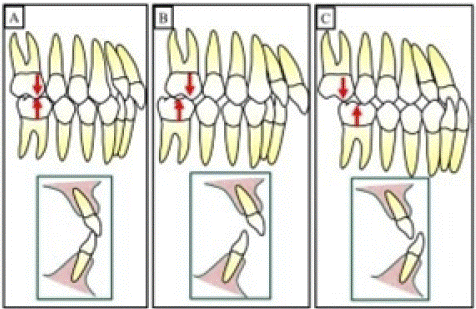
Figure 1: A diagrammatic image illustrating Angle classes—Class I, II, and III. In Class I molar relationship (A), the mesiobuccal cusp of the maxillary first permanent molar aligns with the buccal groove of the mandibular first molar. For Class II molar relationship (B), the mesiobuccal cusp of the maxillary first permanent molar occludes mesial to the buccal groove of the mandibular first molar, indicated by red arrows. Conversely, in Class III molar relationship (C), the mesiobuccal cusp of the maxillary first permanent molar occludes distal to the buccal groove of the mandibular first molar, as shown by red arrows.
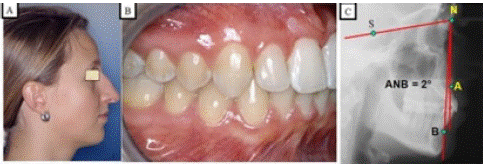
Figure 2: Photos of a patient with class I, a harmony extraoral (A), intraoral (B), skeletal (C), and cephalometric analysis show an ANB angle of 2° (C).

Figure 3: Photos of a patient with class II, a posterior position of the mandible from extraoral (A), intraoral (B), skeletal (C), and cephalometric analysis show an ANB angle of 7° (C).
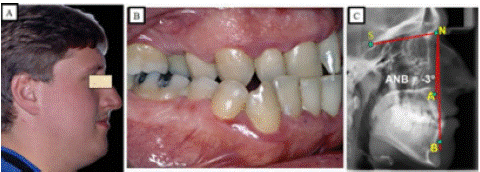
Figure 4: Photos of a patient with class III, an anterior position of the mandible from extraoral (A), intraoral (B), skeletal (C), and cephalometric analysis show an ANB angle of 3° (C).
When looking at the transverse plane, malocclusions are characterized through constriction (crossbite) or heightened expansion (scissor bite) in relation to the occlusal level [7]. The extent of the incisal edges' vertical overlap is represented by overbite on the vertical plane. In the vertical plane, the value is normally 2 mm, but it can vary by up to 2 mm. Open-bite malocclusion, defined as a value less than 0 mm, and deep-bite malocclusion, defined as a value greater than 4 mm, are the two types of malocclusions that result from changes in the measurement of overbite [4,8]. Malocclusion is induced by various reasons, including genetic, environmental, or a mix of both [9]. The formation of a malocclusion is possible as a result of genetically defined factors acting throughout growth [10]. Along with aetiological elements like harmful habits, these impacts may also be present. The child who has a propensity for sucking places his digit, generally the opposable digit, in amidst the dental rows, resulting in the clapper descending. In addition, the thumb's placement next to the front teeth causes them to be more prominent since the tongue cannot develop transversely until it reaches the proper position on the palate. Due to a lack of palate development, children frequently have an anterior open bite and a posterior crossbite [11]. Because the finger is in the way, posterior teeth may also extrude [9]. This is because there is no occlusal contact. Occlusion issues and proper skeletal-facial development are also impacted by lip or cheek sucking. Patients who suck their lower lips exhibit contraction of the lower orbicularis and mental muscles, which results in proclination of the upper teeth, retroclination of the lower teeth, heightened overjet, and irregular alignment of the lower incisors [12]. If we look at oral respiration, it is typically caused by nasal airway obstruction, such as that resulting from adenoid or palatine tonsil enlargement, rhinitis, or turbinates hypertrophy. Patients with this illness cannot breathe via their noses; they breathe through their mouths, which leads to skeletal and dental issues like an open bite, clockwise rotation of the mandible, prognathism, and a narrow palate [13].
Due to the physiological and social alterations this disorder causes, the persistence of malocclusion without any form of therapy can have a detrimental impact on both the quality of life for children and their parents [14]. According to Siluvai et al., 46% of young persons with malocclusion experienced unfavourable lifestyle effects [15]. These issues may include aesthetics, mastication, and phonation. Considering the significance of malocclu- 137 sion in dental medicine, our goal in this investigation is to evaluate the prevalence of this problem across various areas (Figure 5).
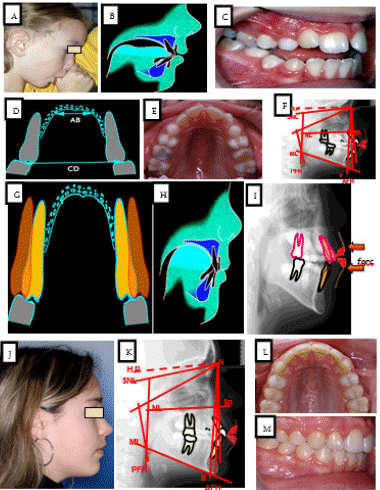
Figure 5: Photos of a child with thumb sucking, incorrect tongue position, narrow maxillary arch, and open bite. Photos in figures A to F show a child with thumb sucking before treatment. The child who has a propensity for sucking places his finger, generally the thumb, in between the dental arches (A), which causes the tongue to slide downward (B); the thumb’s placement next to the front teeth causes them to be more prominent (C) since the tongue is unable to develop transversely until it reaches the proper position on the palate (D and E). The result is an anterior open bite (F). Figures G-I show the treatment strategies and goals, including an expansion of the upper jaw (G) that leads to a normalization of the position of the tongue on the palate (H), an additional physiological palatal expansion, and automatic uprightness of the front teeth (I). Figures J-M show the end of treatment, harmonious face with a physiological lip closure (J), harmonious skeletal situation (K), wide upper jaw (L), and class I occlusion with a physiological overjet, overbite, and (M).
According to E. Angle, who characterized typical dental occlusion "the upper and lower molars ought to be aligned in such a way that the mesiobuccal cusp of the upper molars engages with the buccal groove of the lower molars, forming a harmoniously curved line of occlusion," malocclusion can be divided into four categories: normal occlusion, Class I, Class II, and Class III malocclusion. The World Dental Federation (FDI) also notes that "orthodontic care has progressed to become an essential component of dental medicine aiding in the prevention of oral disorders and enhancing quality of life" and that "malocclusion may impact oral health by elevating the incidence of dental caries, periodontitis, susceptibility to injury and challenges to, swallow, breath and speak [16]. To give reliable data to healthcare decision-makers and enable the distribution of healthcare service assets according to realistic epidemiological findings, data regarding the incidence of malocclusion and the general demand for orthodontic therapy is crucial in this context. Additionally, this knowledge is essential for the educated planning of all orthodontic treatment components and for the dental and orthodontic healthcare providers. Despite these findings, substantial epidemiological research on orthodontic traits is scarce. A potential explanation for this, according to Proffit et al. is the lack of agreement among re-searchers regarding the degree of divergence from the ideal that should be considered normal [17]. Data on the frequency of malocclusion were gathered during the Third Na- 170 tional Health and Nutrition Examination Survey (NHANES III), that took place in Amer- 171 ica between 1989 and 1994. Angle "normal occlusion" was reported to be 30% common, and Angle Class I, II, and III malocclusion were 50-55%, 15%, and 1% common, accordingly. But rather than being physically studied, the molar connection was obtained using overjet measurements, which were said to be more accurately assessed [18,19]. In Chinese schoolchildren, the prevalence of malocclusion was found to be 30.1%, 9.9%, and 4.8% for Angle Classes I, II, and III, respectively. In addition, they said that the most typical malocclusion feature, the deep bite, was seen in 16.7% of the sample [20]. According to different systematic research, there were 54.6%, 24.7%, and 6.0% cases of malocclusion in Iranian children for Angle Classes I, II, and III, respectively [21]. In terms of the cost of care, it is also crucial to be aware of the incidence of severe orthodontic traits including oral clefts, craniofacial abnormalities, oligodontia, and others. In Europe, between 1 out of 500 (0.2%) and 1 out of 700 (0.1%) live newborns had lip, alveolus, or palate clefts, according to the World Health Organization [22]. Our research aims to conduct a thorough evaluation of the available research on the global incidence of malocclusion and other orthodontic traits. The primary objective of this paper is to conduct a comprehensive analysis of published literature addressing the prevalence of skeletal abnormalities and malocclusions across diverse populations. By synthesizing findings from many studies, we aim to offer a nuanced understanding of the commonality of these conditions in various contexts, shedding light on the multifactorial origins of malocclusions. The selection of this topic is underpinned by the recognition of the critical implications of malocclusions, extending beyond mere dental concerns. Numerous publications have underscored the intricate association between malocclusions and functional oral-facial disorders. These disorders, with origins rooted in multifactorial influences, necessitate a comprehensive review to consolidate existing knowledge. We endeavor to elucidate the intricate interplay of factors contributing to malocclusions and to provide a synthesized perspective that may guide future research, clinical practice, and public health initiatives.
While existing literature provides valuable insights into malocclusions, there is a no-table scarcity of research elucidating the dynamics of craniofacial skeletal sphere growth in correlation with the development of primary and permanent dentitions across different age groups. Recognizing this research gap, our study aims to contribute an original perspective, particularly focusing on age-related variations in craniofacial skeletal development. This novel approach not only enhances the uniqueness of our article but also provides a more comprehensive understanding of malocclusion prevalence across diverse populations and age cohorts.
Literature Search Methods
Research Methodology
This study, conducted in adherence to GRADE guidelines (2009 checklist) and PRISMA guidelines, systematically explored skeletal abnormalities and malocclusions from 1990 to September 2023. We sought studies on the prevalence of skeletal abnormalities and malocclusions. We identified papers that met several eligibility requirements: (1) original study or systematic review, (2) English written, (3) prevalence of malocclusion, prevalence of class I malocclusion, (5) prevalence of class II malocclusion, (6) prevalence of class III malocclusion, and (7) incidence of malocclusion and dental anomalies like open bite, deep bite, overjet, crowding, spacing, and crossbite. The following studies were not taken into account: (1) histologic, in vitro, or in silico; (2) reviews; (3) studies focusing on gene expression or transcriptomics without prevalence assessments; (4) studies addressing various conditions where malocclusions were merely touched upon; and studies whose complete texts were unavailable to us or were presented in a different linguistic medium.
Between May and September 2023, An investigation was conducted utilizing the subsequent phrases in PubMed (National Library of Medicine, 8600 Rockville Pike, Bethesda, MD, USA 20894) and Google Scholar (https://scholar.google.com): prevalence of malocclusion, prevalence of class I malocclusion, prevalence of class II malocclusion, prevalence of class III malocclusion, incidence of malocclusion and dental anomalies like open bite, deep bite, overjet, crowding, spacing and crossbite as well as genome-wide association study.
Ethical Considerations
Prior to the commencement of the study, ethical approval was obtained from the relevant institutional review board. All aspects of the research, including patient data handling and privacy, were conducted in accordance with ethical standards and in compliance with institutional guidelines.
Informed Consent
Informed consent was obtained from participants involved in original studies included in the review. The primary studies, which formed the basis for this meta-analysis, had undergone ethical scrutiny and ensured that participants provided informed consent for their data to be used in subsequent analyses.
Literature Search
Between May and September 2023, a systematic search of PubMed and Google Scholar was conducted using predefined search phrases. Three authors independently evaluated titles, abstracts, and database query outcomes, reaching consensus during discrepancies.
Article Selection
The final systematic review included formal evaluations of each qualifying study. The authors conducted quality and bias risk assessments independently, adhering to GRADE standards. Ethical considerations, including patient consent, were integral components of the eligibility criteria for study inclusion by unanimity throughout the title/abstract or full manuscript evaluation processes. Formal evaluations of each qualifying study were incorporated in this systematic review. The authors made separate assessments of the quality and bias risk of the included studies.
Quantification of Data
Quantitative data extraction involved systematically recording prevalence rates of malocclusion subtypes and dental anomalies from the selected studies.
Statistical Analyses
Statistical analyses were performed to synthesize the extracted data, ensuring adherence to ethical standards in research. Pooled prevalence estimates for malocclusion and its subtypes were calculated using random-effects meta-analysis models. This comprehensive methodology, inclusive of ethical considerations, patient consent, and institutional approval, underscores the commitment to the responsible conduct of research. Statistical analyses provide a quantitative synthesis of the data, enhancing the robustness and reliability of the study's findings. The detailed flow chart illustrates the systematic and ethical approach followed in the study.
Results
The preliminary online database query yielded an overall of 1063 items. Following the elimination of replicas, additional title and abstract evaluation, along with a suitability evaluation, led to the successful selection of 98 publications for the qualitative evaluation.
Most research has been conducted on a sample of kids or schoolkids, and it has been done in Europe, followed by Asia, America, and Africa. The topic of sex distribution was left out of many articles. No statistically significant variations in malocclusion prevalence between males and females have been identified, according to some research. Clinical tests, X-rays, study casts, intra- and extra-oral photos, and interviews or questionnaires, haveall been considered by the researchers. The Björk Method or the Angle Categorization, the Index of Orthodontic Therapy demand, or the Dental Aesthetic Index have all been expressly used to evaluate malocclusion and orthodontic traits.
Prevalence of Malocclusion, Types, and Distribution
Sagittal Occlusion
Class I occlusions, Class II malocclusions, Class III malocclusions, and Angle Class I "normal occlusion" had a global mean prevalence that ranged from 1.7 to 93.6%, 7.4 to 84.0%, 0.8 to 72.1%, and 0.5 to 39.1%, respectively. The names, measurements, and frequencies of overjet and reverse overjet varied significantly, as shown in Table 1. Overbite and open bite incidence varied significantly, as seen in Table 1.
Class I
Class II
Class III
Open bite
Deep bite
Cross bite
Spacing
Overjet
Crowding
1
61.40%
24%
10%
*
*
*
*
63.8% 1–4 mm
17.2% 4–6 mm
anterior 50%
10% > 6
posterior 2.5%
2
80.30%
6.3% (3.9% I◦ division, 2.4% II◦ division)
1.60%
7.10%
*
17.10%
60%
30% (increased 15.6%
14.40%
3
86.30%
19.50%
3.90%
1.40%
*
anterior 4%,
*
increased 48%
30.00%
posterior 5%
4
64.30%
17.60%
8%
1.60%
*
anterior 27.5%
15.30%
increased 11.8%
66.60%
posterior 5.1%
5
55.30%
18.80%
1.40%
2.90%
16.90%
6.80%
26.70%
Increased 24.7%,
50.40%
reduced nell’1.8%
6
73%
7.10%
19.40%
1.90%
*
*
*
increased 63%
*
7
46.80%
32.6% (19% divisions)
1.60%
18%
2%
12%
*
14.1%, reduced 2.2%
*
8
42.70%
15.90%
14.10%
2.60%
*
*
*
30.90%
*
9
68.40%
27.70%
2.80%
3.46%
14.46%
8.80%
*
increased 21.09%, reduced 0.9%
upper 44.1%,
lower 40.3%
10
67.13%
I division 14.53%,
7.61%
21.10%
26.30%
anterior 17%,
*
Increased 25.6%,
63.30%
II division 10.7%
posterior 21.4%
reduced 17%
11
52.80%
31.80%
15.40%
4.60%
*
anterior 4.8%
*
increased 22.2%,
*
posterior 9.4%
reduced 11.4%
12
93.60%
4.40%
2%
16.10%
*
*
21.90%
*
*
13
89.45%
8.37%
2.14%
35.97%
14.15%
anterior 8.48%
*
Increased 33.71%,
58.12%
posterior 0.99%
reduced 18.07%
14
34.90%
I division 40%
10.30%
8.20%
14.40%
9.50%
*
Increased 25.1%,
*
II division 4.7%
reduced 10.4%
Table 1: Class I, Class II, Class III, Open bite, Deep bite, Cross bite, Spacing, overjet, and Crowding prevalence for each study. (*the anomaly considered were not investigated).
Transversal Occlusion
Between 1.0 and 36.0% of the populations under observation had a mean prevalence of an unspecified crossbite. Bilateral crossbites varied from 0.0 to 6.5%, unilateral crossbites from 4.0 to 13.5%, and posterior crossbites from 0.3 to 32.0% (Table 2). The weighted mean prevalence of scissor bites was found to range from 0.0 to 14.3% in studies on the subject. A forced bite can occur anywhere between 1.1 and 22.5% of the time, according to some research that has been done.
Variable/ Continent
Africa
America
Asia
Europe
Class I
58.1 ± 33.9%
13.9 ± 4.8%
50.6 ± 26.9%
47.4 ± 17.7%
Class I Malocclusion
71 ± 16.5%
50.6 ± 3.2%
41.5 ± 18.5%
46.8 ± 6.9%
Class II
9.7 ± 8.6%
28.4 ± 11.7%
27.4 ± 14.9%
25.1 ± 8.6%
Class II,1
5.8 ± 5.2%
17 ± 0.0% *
19.5 ± 15.2%
16.1 ± 5.7%
Class II, 2
1.4 ± 0.0%
5.3 ± 0.0% *
4.2 ± 1.9%
4.9 ± 2.6%
Class III
4.8 ± 4.2%
13.9 ± 15.8%
7.8 ± 4.2%
3.4 ± 2.6%
FTP
35.9 ± 17.4%
73.9 ± 17.6%
41.6 ± 6.7%
28.1 ± 14.7%
DS
0.9 ± 1.0%
7.9 ± 3.0%
10.2 ± 1.4%
24.9 ± 8.8%
MS
54.8 ± 11.0%
15.9 ± 16.7%
36.4 ± 1.5%
47.6 ± 4.7%
Crossbite (Not Specified)
1.2 ± 0.0% *
NA
8.9 ± 14.0%
5.1 ± 2.9%
Posterior Crossbite (Not Specified)
5.5 ± 2.8%
9.3 ± 6.3%
6.6 ± 7.0%
8.9 ± 4.3%
Posterior Crossbite Unilateral
5.5 ± 0.0% *
13.0 ± 1.2%
5.0 ± 2.1%
8.6 ± 1.8%
Posterior Crossbite Bilateral
1.6 ± 0.0% *
3.8 ± 1.4%
5.0 ± 1.0%
1.6 ± 1.1%
Anterior Crossbite
5.5 ± 1.9%
4.9 ± 3.9%
10.3 ± 6.5%
5.6 ± 4.0%
Scissor Bite
10.3 ± 4.8%
1.0 ± 0.6%
1.8 ± 1.6%
1.0 ± 1.5%
Forced Bite/Crossbite with Frontal/Lateral Shift
14.7 ± 10.3%
NA
11.9 ± 4.8%
13.7 ± 5.5%
Agenesis/Hypodontia
3.4 ± 2.2%
5.0 ± 3.3%
8.1 ± 6.3%
6.9 ± 3.2%
Mesiodens
NA
1.5 ± 0.0% *
NA
1.3 ± 0.9%
Supernumerary Teeth/Hyperdontia
0.3 ± 0.2%
1.9 ± 0.4%
2.7 ± 1.6%
2.3 ± 1.3%
Hypo- Hyperdontia
NA
NA
NA
0.4 ± 0.1%
Impacted/Retained Teeth (Impeded Eruption)
3.0 ± 0.0% *
3.9 ± 2.9%
4.8 ± 4.1%
3.8 ± 0.8%
Ectopic Eruption
9.7 ± 0.0% *
1.5 ± 0.0% *
6.0 ± 4.0%
7.5 ± 0.0% *
Transposition
0.2 ± 0.1%
NA
0.5 ± 0.4%
1.3 ± 0.7%
Crowding Maxillary Arch
23.8 ± 11.8%
17.3 ± 4.3%
35.3 ± 21.3%
15.6 ± 19.0%
Crowding Mandibular Arch
24.8 ± 10.6%
12.3 ± 2.7%
35.4 ± 23.7%
23.3 ± 19.4%
Crowding
24.5 ± 15.9%
42.1 ± 7.3%
40.4 ± 22.2%
28.1 ± 11.2%
Spacing Maxillary Arch
32.2 ± 14.4%
1.8 ± 0.0% *
24.9 ± 17.2%
44.0 ± 15.7%
Spacing Mandibular Arch
22.0 ± 8.5%
1.3 ± 0.0% *
10.7 ± 5.9%
14.4 ± 2.5%
Spacing
32.6 ± 10.7%
23.5 ± 4.7%
16.7 ± 14.3%
7.2 ± 13.5%
Midline Diastema
36.8 ± 0.0% *
11.1 ± 7.3%
8.3 ± 4.8%
30.9 ± 20.9%
Table 2: Prevalence of angle classification and deciduous molar occlusion, different transversal malocclusions, anterior crossbite, tooth anomalies, and space anomalies according to geographical location.
Tooth Anomalies
Hypodontia (wisdom teeth lacking) was found to have a mean prevalence range of 0.0-18.6%. In comparison to hyperdontia, mesiodens had a mean prevalence of 0.2-4.5%, and vice versa (Table 2). X-rays were utilized in each of these tests. Hypohypodontia, or the simultaneous occurrence of both anomalies in the same individual, was quite prevalent, with a prevalence of 0.3-0.5%. Impacted teeth, ectopic eruptions, and transposed teeth are other dental abnormalities that have received little research attention. According to reports, the typical rates of transposition, ectopic eruption, and impacted teeth were between 0.1 and 1.4%, 0.9 and 11.1%, and 0.5 and 12.9%, respectively.
Space Anomalies
In many of the research evaluating this metric, crowding needed to be defined. The other research employed the Irregularity Index [23], the Björk technique [24], the overlapping of erupted teeth as a result of a shortage of room or space for teeth to erupt in the dental arch [25,26], and others. The mean prevalence of crowding ranged from 0.8 to 93.4% generally. A weighted mean prevalence for crowding was discovered in the range of 1.7-77.9% and 0.3-83.3%, respectively, when the maxillary and mandibular arches were evaluated independently (Table 2). upper The and lower jaws, respectively, had a mean prevalence of spacing that ranged from 1.8 to 62.2% and 1.3 to 30.0%. The mean prevalence of 315 spacing was observed to be between 1.2 and 59.5%. A midline diastema's weighted mean 316 prevalence was found to be between 1.0 and 73.0%.
Oral Habits
The oral habits were discussed in the reported papers, some of which concentrated on long-term changes while others only highlighted oral habits in relation to malocclusion. From 10.9% to 40.2% of people reported having oral habits.
Regional Variations
The incidence of malocclusion and the occlusal characteristics examined, and the proportion of malocclusion that each country accounts for globally are all displayed in Table 2 and Figures 6 through 10. For this, the research was divided into the following groups by continent: Europe, North and South America, and Asia. a measure of malocclusion's prevalence across the nation.
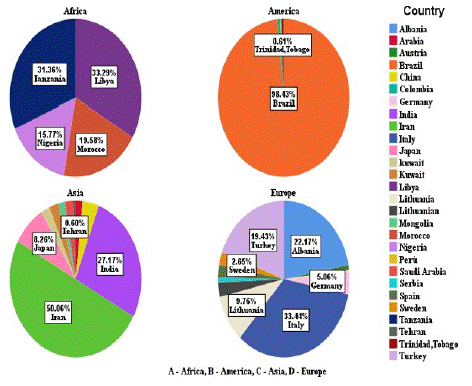
Figure 6: Country-wise contribution of malocclusion to the total malocclusion in a particular continent. A-Africa, B – America, C- Asia, E- Europe.
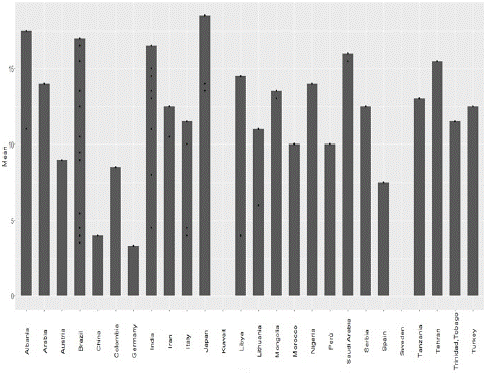
Figure 7: Country-wise mean population age (Range Mean) of malocclusion in different countries.
X axis – country, Y axis - range mean
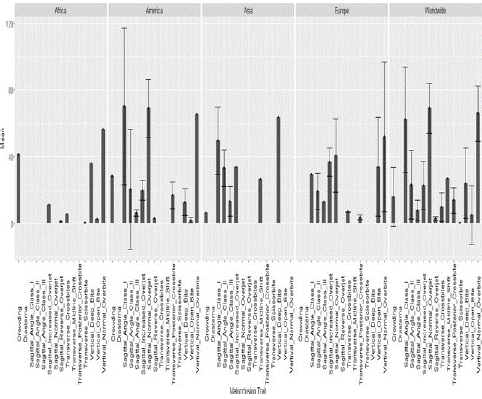
Figure 8: Primary dentition classification of the different traits of malocclusions means (%) and their standard deviations (SD) in a particular continent. X axis- malocclusion trait, Y axis- mean (%) and SD.
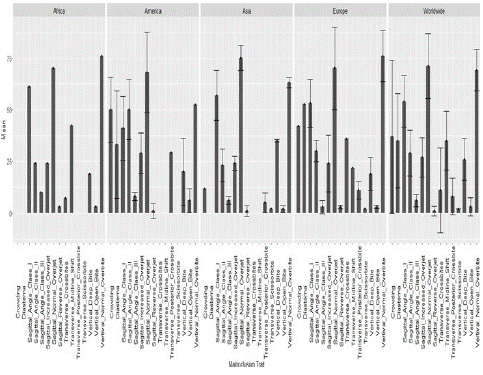
Figure 9: Mixed dentition classification of the different traits of malocclusions means (%) and their standard deviations (SD) in a particular continent. X axis- malocclusion trait, Y axis- mean (%) and SD.
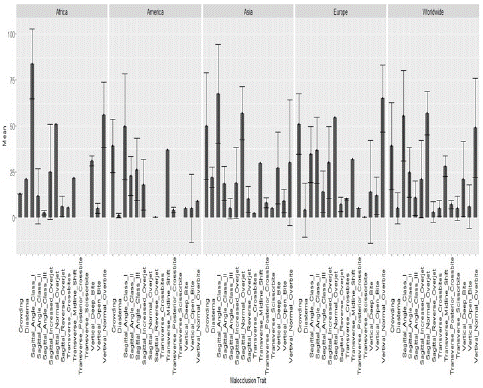
Figure 10: Permanent dentition classification of the different traits of malocclusions means (%) and their standard deviations (SD) in a particular continent. X axis- malocclusion trait, Y axis- mean (%) and SD.
Discussion
The first tooth class, which is specified by angle, ranks as the utmost frequently mentioned, succeeded by the second and lastly the third category, according to a review of the literature. The division of the second class, which has received limited analysis and has only been taken into account in three studies, may also be a topic for additional inquiry. Increased overjet was frequently observed in the trials under consideration. Low, ranging from 0.4% to 18.07%, reduced overjet frequency was observed. With the exception of three studies, analysis in the vertical plane showed that the frequency of open bite was quite variable [27], but the frequency spectrum encompassed modest and comparable ranges amid 1.4% and 8.2%. With the exception of a study from Italy, where the prevalence was 2%, the examination of deep bite, however, showed more consistent values. All the other studies fell within a significantly smaller range of values. In all the populations analysed, results for deep bite were identical, which makes it an abnormality. A variety in the prevalence of crossbites was found by the cross-sectional analysis. Only five studies distinguished between anterior and posterior crossbite; hence, more research is needed to determine the varied prevalence. With a prevalence of up to 84% among the other anomalies,
crowding was undoubtedly one of the most common. With only four studies taken into considerations, the frequency of spacing, on the other hand, was scarcely examined. However, in a study, the prevalence of this tooth issue was extremely high, at 60%. When comparing prevalence across nations and, at times, even within the same country, most of the kinds of malocclusion that we looked at showed.
The WHO states that before an epidemiological survey can be conducted, the investigators must choose either to conduct it at a locally, regionally, or nationally, the factors to be examined, and the age categories to be included [28]. Clear descriptions of the study variables, measurement procedures, and results recording procedures should be supplied prior to the study's commencement. Conducting ananticipated estimate of the sample size and potential subsamples is indicated because regional and ethnicity data are also essential [28,29], due to the requirement that diagnostic standards be founded on similar data from a representative sample. To assess any selection and/or design bias, all the materials and techniques should be documented in detail when reporting the results.
Deep bite and heightened overbite are evaluated by measuring the vertical overlap of the incisors perpendicular to the occlusal plane, either in millimetres as a percentage of incisor overlap, or described qualitatively by depicting the contact of lower incisors to the upper arch or palate. Deep bite is commonly classified into dentoalveolar origin (overeruption of teeth) and skeletal origin (reduced lower face height, low mandibular plane angle) [30]. The frequency of deep bite varies from 8.4 to 51.5%, contingent on threshold values, ethnic group, and gender [31,32]. The prevalence of palatal non-traumatic tooth contact and palatal impingement spans from 5.9 to 15.9% [31,32]. Angle classification has been associated with vertical and/or cephalometric patterns [33]. Class II malocclusion is notably connected to increased overbite in contrast to class I malocclusion [32,34]. Class II Division 2, occurring less frequently at 5.3% [35], might be linked with a deep bite [36]. The literature describes a connection between heightened overbite and retrusive incisors in both Angle Class I and Class II Division 2 malocclusions.
One crucial element in any given epidemiological study is the sample size [37-40]. The included studies revealed size variance ranges among different people, which may help to explain some of the wide variations in the prevalence of the malocclusion features that have been investigated. Since people seek dental or orthodontic care for a reason, using patient samples can introduce additional bias compared to using random samples. In this regard, using a population-based sample as opposed to patient populations is preferred when conducting an epidemiological study. Because there are so many ways to evaluate various orthodontic aspects, it is challenging to come to firm conclusions on certain orthodontic factors. The description of overjet contains a few instances of this contradiction. The investigations incorporated in this analysis characterized heightened overjet as exceeding 2.5 millimetres [41], >3 mm [26] >4 mm [42], and >6 mm [43], Making data comparison difficult. As a result of this variation in the way information is presented, it was unable to differentiate between the occurrence of dental alignment based on age or dental development phase because the majority of papers present groupings having a wide age spectrum and do not differentiate The Dental Aesthetic Index (DAI), This complies with WHO recommendations for standardizing the epidemiological information on malocclusion and its therapeutic needs, was used to describe the outcomes of many studies [28]. Because it doesn't account for occlusal factors including crossbite, asymmetry, midline deviation, missing molars, or impacted teeth, the DAI is only a partial indicator of malocclusion and is more of an aesthetic treatment requirement index [44].
Additional investigations employed the Dental Health Component of the Index of Orthodontic Treatment Need (IOTN) to evaluate various orthodontic aspects (Table 1). Only the IOTN, according to Araki et al., can determine the kind of malocclusion, such as increased or reverse overjet, overjet, deep bite, open bite, and crowding [42]. Despite the fact that they evaluate certain orthodontic characteristics, the IOTN and DAI were created to determine the need for orthodontic treatment rather than to conduct epidemiological surveys on the incidence of orthodontic features [45]. This systematic review included 39 studies that employed X-rays, 10 of which were done on youngsters. According to the British Orthodontic Society, clinical justification for each radiograph is essential, as prescribing a radiograph constitutes a procedure with a low yet implied risk [46]. In this situation, it is still difficult to detect various orthodontic traits because obtaining radiographs for epidemiological research is not always necessary, including instances of hypodontia, impacted teeth, or retained teeth, and so on.
The development of malocclusion can be influenced by oral habits [47]. In cases of prolonged thumb and finger-sucking behaviours, elevated overjet, diminished overbite, and the presence of a crossbite may become evident in preadolescent children. Thumb and finger-sucking behaviours can also result in an open bite [48]. According to research by Schmid et al. [49], the use of pacifiers is associated with a higher prevalence of anterior open bites and posterior crossbites. In addition, clapper push when deglutition or while in relaxed state might result in malocclusions such as an open bite [18]. Decreasing from 40.2% during deciduous dentition to 26.1% in mixed dentition, according to Stahl et al.'s research [50], oral habits have decreased. Studies rarely include the methods for diagnosing infantile swallowing, sucking patterns, or tongue position, and most of these are on the basis of unreliable information. Frequently, the evaluation of a kid's present and historical mouth-related behaviors is reliant on data gathered from the caregivers, either explicitly or via questionnaires with questionable reliability [47]. Technology that enables the objective quantification of oral habits is therefore urgently needed. Also worth noticing are the regional variations in the occurrence of malocclusion features. For example, the occurrence of Angle Class II malocclusion was noted to be approximately 25% in America, Asia, and Europe [51], whereas the average prevalence in Africa was 8.80 to 10.36%. According to Proffit's findings that Class III malocclusions are more common in Asian populations, the weighted average incidence of Class III malocclusions in Europe, America, Africa, and Asia is 3.4 1.4%, 4.1 1.4%, 4.8 4.2%, and 7.8 4.2%, respectively [52,53]. The mean prevalence of anterior crossbite was most notable in Asia (10.3 ± 6.5%) and least in America (1.0 ± 0.6%). Concerning transversal discrepancies, a forced bite was more prevalent in Africa (14.7 ± 10.3%), followed by Europe (13.7 ± 5.5%), and a scissor bite was more frequent in Africa (10.3 ± 4.8%), while posterior crossbites were more common in America (13.0 ± 1.2%) than in Africa (5.5 ± 2.8%). Concerning hypodontia, the prevalence of dental anomalies ranged from 3.4 ± 2.2% in Africa to 8.1 ± 6.3% in Europe. As for hyperdontia varied from 0.3 ± 0.2% in Africa to 2.7 ± 1.6% in Asia.
Conclusion
The geographic variations discovered in this systematic analysis are consistent with the results published by Cenzato et al., who hypothesize that each community's genetic and environmental variables impact malocclusion traits and play a role in these geographical variances [54]. However as previously noted by Anthonappa et al. [55], these Variations can be attributed to the wide range of research designs, dental problem categorizations and the absence of specific worldwide nomenclature. The vast ranges stated in the papers included in this study as well as the variance in the number of research conducted on each region may have additionally contributed to the observed geographic differences. The statistics regarding malocclusion prevalence are uncertain since the included studies used a variety of techniques to determine the prevalence of orthodontic and malocclusion traits. Orthodontic epidemiological research necessitates the quick development of methodological protocols, which should be accepted by academic institutions and professional organizations. Only in this way can accurate data be gathered that can be used to support recommendations to the healthcare sector and other key parties.
Author Statements
Author Contributions
Conceptualization, F.A.I., P.P., and N.W.; Methodology, I.M.L., O.Z. and K.M.; Validation, F.A.I..; Investigation, I.M.L. O.Z. K.M. and N.W.; Resources, F.A.I., P.P., and N.W; Data Curation, I.M.L. O.Z. and K.M.; Writing—Original Draft Preparation, O.Z. and I.M.L..; Writing—Review and Editing, P.P. N.W. and F.A.I.; Supervision, F.A.I.; P.P., and N.W; Project Administration, F.A.I.; Funding Acquisition, F.A.I., P.P., and N.W All authors have read and agreed to the published version of the manuscript.
Funding
This study was supported by core funds from Tel Aviv University and the University Hospital of Regensburg.
Institutional Review Board Statement
Ethical review and approval were waived for this study since no intervention procedure involved patients or biological sample collection. However, we used ICS from patients to use their cephalometric images.
Informed Consent Statement
Informed consent was obtained from all subjects involved in the study.
Data Availability Statement
This study did not report any data.
Conflicts of Interest
The authors declare no conflict of interest.
References
- Dos Santos RR, Nayme JG, Garbin AJ, Saliba N, Garbin CA, Moimaz SA. Prevalence of malocclusion and related oral habits in 5-to 6-year-old children. Oral Health Prev Dent. 2012; 10: 311–8.
- Mtaya M, Brudvik P, Astrøm AN. Prevalence of malocclusion and its relationship with socio- demographic factors, dental caries, and oral hygiene in 12- to 14-year-old Tanzanian schoolchildren. Eur J Orthod. 2009; 31: 467–76.
- Gelgör IE, Karaman AI, Ercan E. Prevalence of malocclusion among adolescents in central anatolia. Eur J Dent. 2007; 1: 125–31.
- Maspero C, Galbiati G, Giannini L, Guenza G, Farronato M. Class II division 1 malocclusions: Comparisons between one and two-step treatment. Eur J Paediatr Dent. 2018; 19: 295–9.
- Farronato G, Maspero C, Chimenti C, Festa F, Giannì AB, Alvaro CM, et al. Ortognatodonzia 1st ed. Edi-Ermes: Milan. 2013; 1.
- Masucci C, Oueiss A, Maniere-Ezvan A, Orthlieb JD, Casazza E. What is a malocclusion? L’Orthodontie Française. 2020; 91: 57–67.
- Lanteri V, Maspero C, Cavone P, Marchio V, Farronato M. Relationship between molar deciduous teeth infraocclusion and mandibular growth: A case-control study. Eur J Paediatr Dent. 2020; 21: 39–45.
- Maspero C, Begnoni G, Magnani A, Farronato M, Khomchyna N, Dellavia C. Rapid Maxillary Expander and Eruption Guidance Appliance therapy in skeletal Class II: Cephalometric considerations. Eur J Paediatr Dent. 2019; 20: 280–4.
- Zou J, Meng M, Law CS, Rao Y, Zhou X. Common dental diseases in children and malocclusion. Int J Oral Sci. 2018; 10: 1–7.
- Marcomini L, Lucato AS, Santos JLB, Tubel CAM. Prevalence of malocclusion and its relationship with functional changes in the breathing and in the swallowing. Braz Dent Sci. 2010; 13: 52–8.
- Abate A, Cavagnetto D, Fama A, Maspero C, Farronato G. Relationship between Breastfeeding and Malocclusion: A Systematic Review of the Literature. Nutrients. 2020; 12: 3688.
- Germeç D, Taner TU. Lower lip sucking habit treated with a lip bumper appliance. Angle Orthod. 2005; 75: 1071–6.
- Muñoz ICL, Orta PB. Comparison of cephalometric patterns in mouth breathing and nose breathing children. Int J Pediatr Otorhinolaryngol. 2014; 78: 1167–72.
- Johal A, Cheung MYH, Marcenes W. The impact of two different malocclusion traits on quality of life. Br. Dent J. 2007; 202: E2.
- Siluvai S, Kshetrimayum N, Reddy CV, Siddanna S, Manjunath M, Rudraswamy, S. Malocclusion and related quality of life among 13- to 19-year-old students in Mysore City—A cross-sectional study. Oral Health Prev. Dent. 2015, 13, 135–141.
- Federation WD. From Strictly Aesthetics to an Integral Part of Oral Health: A Brief History of Orthodontics through the Ages. Oral Health Prev Dent. 2015; 13: 135–41.
- Proffit WR, Fields HW Jr, Moray LJ. Prevalence of Malocclusion and Orthodontic Treatment Need in the United States: Estimates from the NHANES III Survey. Int J Adult Orthod Orthognath Surg. 1998; 13: 97-106 526.
- Proffit WR, Fields HW, Larson B, Sarver DM. Contemporary Orthodontics-e-Book. London, UK: Mosby. 2018.
- Brunelle J, Bhat M, Lipton J. Prevalence and distribution of selected occlusal characteristics in the US population, 1988–1991. J Dent Res. 1996; 75: 706–13.
- Lin M, Xie C, Yang H, Wu C, Ren A. Prevalence of malocclusion in Chinese schoolchildren from 1991 to 2018: A systematic review and meta-analysis. Int J Paediatr Dent. 2020; 30: 144–55.
- Akbari M, Lankarani K, Honarvar B, Tabrizi R, Mirhadi H, Moosazadeh M. Prevalence of malocclusion among Iranian children: A systematic review and meta-analysis. Dent Res J. 2016; 13: 387-395.
- International Clearinghouse for Birth Defects Monitoring Systems. International Centre for Birth Defects WHGP, European Registration of Congenital Anomalies. World Atlas of Birth Defects 2nd Edition. World Health Organization. 2003.
- Ferro R, Besostri A, Olivieri A, Stellini E. Prevalence of occlusal traits and orthodontic treatment need in 14 year-old adolescents in Northeast Italy. Eur J Paediatr Dent. 2016; 17: 36-42.
- Murshid Z, Amin HE, Al-Nowaiser A. Distribution of certain types of occlusal anomalies among Saudi Arabian adolescents in Jeddah city. Community Dent Health. 2010; 27: 238–41.
- Dacosta OO. The prevalence of malocclusion among a population of northern Nigeria school children. West Afr J Med. 1999; 91–6.
- Martins Mda G, Lima KC. Prevalence of malocclusions in 10-to 12-year-old schoolchildren in Ceará, Brazil. Oral Health Prev Dent. 2009; 7: 217–23.
- Lone IM, Zohud O, Midlej K, Paddenberg E, Krohn S, Kirschneck C, et al. Anterior Open Bite Malocclusion: From Clinical Treatment Strategies towards the Dissection of the Genetic Bases of the Disease Using Human and Collaborative Cross Mice Cohorts. Journal of Personalized Medicine. 2023; 13: 1617.
- Organization WH. Oral Health Surveys: Basic Methods. 4th ed. ORH/EPID: Geneva. 1997.
- Slim K, Nini E, Forestier D, Kwiatkowski F, Panis Y, Chipponi J. Methodological index for non-randomized studies (MINORS): Development and validation of a new instrument. ANZ J Surg. 2003; 73: 712–6.
- Nielsen IL. Vertical Malocclusions: Etiology, Development, Diagnosis and Some Aspects of Treatment. Angle Orthodontist. 1991; 61: 247-60.
- Watted N, Lone IM, Osayd Zohud O, Midlej K, Proff P, Iraqi FA. Comprehensive Deciphering the Complexity of the Deep Bite: Insight from Animal Model to Human Subjects. J Pers Med. 2023; 13: 1472.
- Lux CJ, Dücker B, Pritsch M, Komposch G, Niekusch U. Occlusal Status and Prevalence of Occlusal Malocclusion Traits among 9-Year-Old Schoolchildren. Eur J Orthod. 2009; 31: 294-299.
- Ota K, Arai K. Prevalence and Patterns of Tooth Agenesis in Angle Class II Division 2 Malocclusion in Japan. American Journal of Orthodontics and Dentofacial Orthopedics. 2015; 148: 123-9.
- Lone IM, Zohud O, Midlej K, Awadi O, Masarwa S, Krohn S, et al. Narrating the Genetic Landscape of Human Class I Occlusion: A Perspective-Infused Review. J Pers Med. 2023; 13: 1465.
- Upadhyay M, Nagaraj K, Yadav S, Saxena R. Mini-Implants for En Masse Intrusion of Maxillary Anterior Teeth in a Severe Class II Division 2 Malocclusion. J Orthod. 2008; 35: 79-89-.
- Brezniak N, Arad A, Heller M, Dinbar A, Dinte A, Wasserstein A. Pathognomonic cephalometric characteristics of Angle Class II Division 2 malocclusion. Angle Orthod. 2002; 72: 251-7.
- Lone IM, Iraqi FA. Genetics of Murine Type 2 Diabetes and Comorbidities. Mamm Genome. 2022; 33: 421–36.
- Zohud O, Lone IM, Nashef A, Iraqi FA. Towards system genetics analysis of head and neck squamous cell carcinoma using the mouse model, cellular platform, and clinical human data. Animal Model Exp Med 2023.
- Lone IM, Ben Nun N, Ghnaim A, Schaefer AS, Houri-Haddad Y, Iraqi FA. High-Fat Diet and Oral Infection Induced Type 2 Diabetes and Obesity Development under Different Genetic Backgrounds. Anim Model Exp Med. 2023; 6: 131–45.
- Atamni HJ, Lone IM, Binenbaum I, Mott R, Pilalis E, Chatziioannou A, et al. Mapping novel QTL and fine mapping of previously identified QTL associated with glucose tolerance using the collaborative cross mice. Mammalian Genome. 2023; 35: 31–55.
- Berneburg M, Zeyher C, Merkle T, Möller M, Schaupp E, Göz G. Orthodontic findings in 4- to 6-year-old kindergarten children from southwest Germany. J Orofac Orthop. 2010; 71: 174–86.
- Alajlan SS, Alsaleh MK, Alshammari AF, Alharbi SM, Alshammari AK, Alshammari RR. The prevalence of malocclusion and orthodontic treatment need of school children in Northern Saudi Arabia. J Orthod Sci. 2019; 8: 10.
- Araki M, Yasuda Y, Ogawa T, Tumurkhuu T, Ganburged G, Bazar A, et al. Associations between Malocclusion and Oral Health-Related Quality of Life among Mongolian Adolescents. Int J Environ Res Public Health. 2017; 14: 902.
- Singh A, Purohit B, Sequeira P, Acharya S, Bhat M. Malocclusion and orthodontic treatment need measured by the Dental Aesthetic Index and its association with dental caries in Indian schoolchildren. Community Dent Health. 2011; 28: 313–6.
- Jenny J, Cons NC. Comparing and contrasting two orthodontic indices, the Index of Orthodontic Treatment need and the Dental Aesthetic Index. Am J Orthod Dentofac Orthop. 1996; 110: 410–6.
- Isaacson KG, Thom AR, Atack NE, Horner K, Whaites E. Guidelines for the Use of Radiographs in Clinical Orthodontics, 4th ed.;British Orthodontic Society. London, UK. 2015; 1–28.
- Kasparaviciene K, Sidlauskas A, Zasciurinskiene E, Vasiliauskas A, Juodzbalys G, Sidlauskas M, et al. The Prevalence of Malocclusion and Oral Habits among 5–7-Year-Old Children. Med Sci Monit. 2014; 20: 2036–42.
- Silva M, Manton D. Oral habits—Part 1: The dental effects and management of nutritive and non-nutritive sucking. J Dent Child. 2014; 81: 133–9.
- Schmid KM, Kugler R, Nalabothu P, Bosch C, Verna C. The effect of pacifier sucking on orofacial structures: A systematic literature review. Prog Orthod. 2018; 19: 8.
- Stahl F, Grabowski R, Wigger K. Epidemiological significance of Hoffmeister’s “Genetically determined predisposition to disturbed development of the dentition.” J Orofac Orthop. 2003; 64: 243–55.
- Lone IM, Zohud O, Midlej K, Proff P, Watted N, Iraqi FA. Skeletal Class II Malocclusion: From Clinical Treatment Strategies to the Roadmap in Identifying the Genetic Bases of Development in Humans with the Support of the Collaborative Cross Mouse Population. J Clin Med. 2023; 12: 5148.
- Lone IM, Zohud O, Nashef A, Kirschneck C, Proff P, Watted N, et al. Dissecting the Complexity of Skeletal- Mal-occlusion-Associated Phenotypes: Mouse for the Rescue. Int J Mol Sci. 2023; 24: 2570.
- Zohud O, Lone IM, Midlej K, Obaida A, Masarwa S, Schröder A, et al. Towards Genetic Dissection of Skeletal Class III Malocclusion: A Review of Genetic Variations Underlying the Phenotype in Humans and Future Directions. J Clin Med. 2023; 12: 3212.
- Cenzato N, Nobili A, Maspero C. Prevalence of dental malocclusions in different geographical areas: Scoping review. Dent J. 2021; 9: 117.
- Anthonappa RP, King NM, Rabie A. Systematic review: Diagnostic tools used to predict the prevalence of supernumerary teeth: A meta-analysis. Dentomaxillofac Radiol. 2012; 41: 444–9.